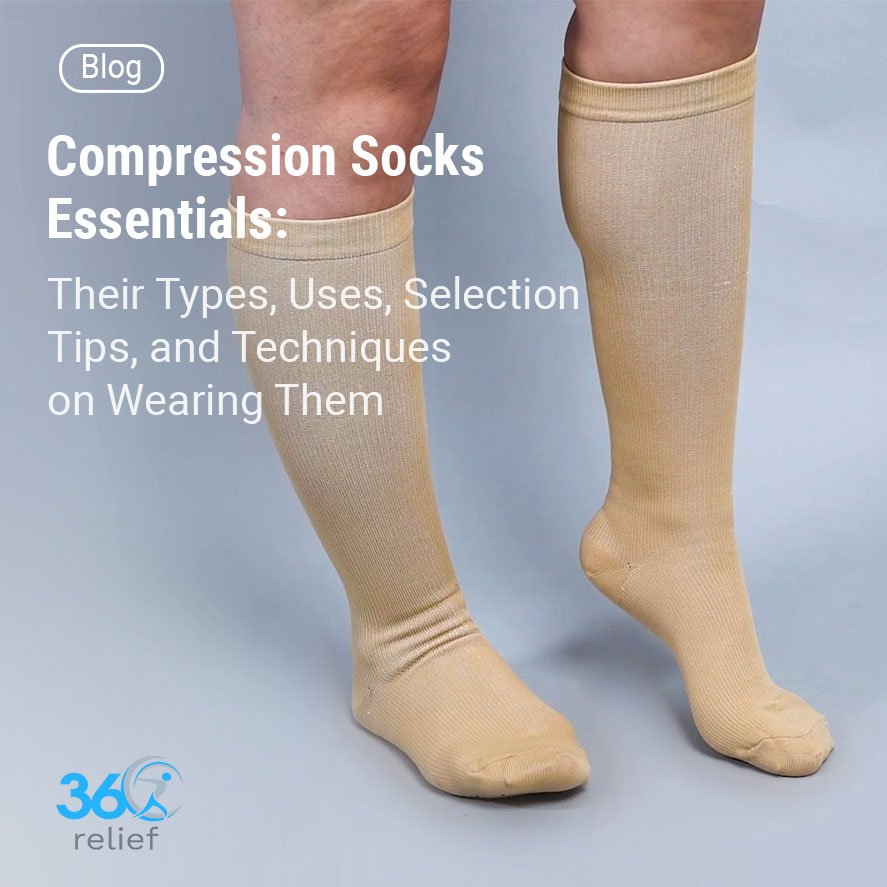
Make This Christmas Pain-Free: 10% Off on Supportive Wear!
Holidays are coming, which means that let’s welcome them with joy, laughter, and, of course, some comfort! At 360 Relief,

Compression socks are specialised garments, different from normal socks, helping provide targeted compression or pressure to legs and feet. Whether you are a regular traveller, a professional nurse, participate in athletic activities or an expectant mother, you may suffer from poor blood circulation problems to some extent. Here come compression socks that help boost your blood circulation, avoiding the risks of clot formation or any other circulation-related injuries. This article is a detailed account of the compression socks essentials. Throughout this article, we have discussed the common types and uses of compression socks. As well as this, you can get professional tips on choosing the right option for you. We have concluded this discussion with the best techniques and guide on wearing compression socks. So, let’s begin our discussion here;
Table of Contents
ToggleCompression socks are designed in different ways (compression levels) to meet the specific needs of users or wearers. For example, some compression socks are best for eliminating swelling and discomfort, some are best at reducing fatigue, some are best at improving circulation, and so on. The following are the common types of compression socks used on a large scale:
Graduated compression socks are designed to provide pressure or compression at different levels. This pressure is high at the bottom or ankle and gradually decreases upwards. Graduated compression socks help in a variety of conditions, including preventing blood from pooling, increasing blood circulation, minimising swelling, and reducing the risk of deep vein thrombosis, also known as DVT.
Anti-embolism compression socks are specifically designed to be used in medical conditions to prevent blood clot formation. These socks help in exerting consistent but moderate pressure on the legs. These socks can be beneficial for a variety of conditions, including promoting blood flow, preventing venous stasis, and reducing the risk of clot formation. The socks are specifically recommended for wear by patients who are recovering from surgery or are immobile.
Non-medical socks or hosiery are designed to offer mild compression levels. These socks are often used for fatigue reduction, general leg comfort, and offering a slight boost to blood circulation. These are not designed to treat any medical condition. These can be worn for daily life routines when you feel discomfort.
Compression socks are designed in different styles to meet the specific requirements of individual people. Here we come with the top styles used to design compression socks:
From preventing pain, swelling, and fatigue during sports, travelling and daily life routines, to promoting recovery or healing from injury or surgery, compression socks are worn for a variety of purposes. Below are the common uses of compression socks:
People involved in long hours of flights may be prone to swelling, leg fatigue, or circulation problems in the lower legs. Wearing compression socks for flying can help improve blood circulation and reduce the risk of blood clot formation. Thus, they help enhance overall comfort during long-hours flights.

Nurses are required to work for long hours on their feet. This practice may make them prone to leg discomforts, including pain, fatigue, and swelling. Wearing compression socks helps nurses reduce the chances of swelling and pain during long shifts or duties.

Hormonal changes and other conditions during pregnancy can cause pain and swelling in the lower legs. Wearing compression socks for pregnancy helps reduce leg swelling, promote blood circulation, and manage fluid retention, contributing to a healthy pregnancy experience.
It’s crucial to know when to wear compression socks during pregnancy. For this purpose, you must consult your healthcare professionals and let them decide when and how to wear compression socks to make your pregnancy session healthy.

Venous diseases may result from several medical conditions and other reasons. These diseases may include deep vein thrombosis, varicose veins, spider veins, and others. The common reason behind these venous problems is poor blood circulation. Wearing compression socks for venous problems helps improve blood circulation in the lower legs, improving the symptoms of venous problems.

Athletes and other sports professionals involved in continuous running and other strenuous activities may experience pain, swelling, and fatigue in the lower legs. Wearing compression socks for sports helps improve blood circulation throughout the sports session, helping reduce the risks of circulation problems.

People who are prone to leg problems during their normal routine or everyday lifestyle are also recommended to wear compression socks. Wearing compression socks helps keep your legs warm and active throughout their daily activities, helping prevent the chances of circulation-related injuries.

Choosing the right type of compression socks guarantees maximum benefits. Here we come with the possible tips, to help you choose the right compression socks according to your needs:
You must follow all other instructions, as recommended by your GP or healthcare professionals, maximising the results or benefits.
The wearing guide for compression socks comprises different factors, including the recommended time, the right type or size, and the compression levels. It is advisable to ask your GP or healthcare advisors to choose the right type and size. As well as this, ensure that you wear the compression socks under the time period set by your healthcare professional. Remember that wearing compression socks for a long or extended period may cause circulation or skin problems. Also, ensure that the compression socks are properly fitted. Too much tight compression socks may cut blood circulation, on the other hand, loosely fitted compression socks may not be able to provide needed compression.

Holidays are coming, which means that let’s welcome them with joy, laughter, and, of course, some comfort! At 360 Relief,

Happy Cyber Monday to everyone; it is a perfect occasion for 360 Relief to offer a special discount of 10%

This Black Friday, take advantage of exclusive 10% savings on some of 360 Relief’s best-selling compression socks and support braces!

Everyday life includes walking up stairs, but knee discomfort can make this basic activity difficult. Walking up or down stairs

Cooking is a beloved activity for many, but for those struggling with knee pain, standing in the kitchen can quickly

We’ve all been there. On a ride in a car, for instance, to the country home for a weekend break

Gardening is enjoyable for many people and those who like tending to their lawns and plants usually find it therapeutic

Do you have a painful knee problem that takes you to physiotherapy…for an injury that hampers your daily living…your workout

Training can be very much associated with some pains and injuries that may be experienced by the trainers. As there

Office workers often spend hours seated at their desks, focusing on tasks while unknowingly putting their health at risk. The

Winter often brings more than just a change in weather; for many, it also means dealing with unexpected swelling in

Compression socks have become a critical tool for athletes across all sports. Whether you’re a marathon runner, cyclist, or weightlifter,

October marks the beginning of National Cholesterol Month in the UK, a time dedicated to raising awareness about cholesterol and

Overall, there is nothing to match the experience of watching musicians perform live in an outdoor concert in Glastonbury. However,

Today charity runs have gained popularity as a way of raising cash for a cause in the United Kingdom. From
Please enter your email to subscribe to our newsletter for exclusive offers and updates
Copyright © 2025 | 360 Relief Ltd | Sitemap

